Managerial Accounting System in Contemporary Organizations
VerifiedAdded on 2022/10/04
|17
|4191
|14
Report
AI Summary
This report delves into the realm of managerial accounting, exploring various techniques and their applications within contemporary organizations. It begins by identifying different types of management accounting methods, such as Activity-Based Costing (ABC) and World Class Manufacturing (WCM), and SAP R/3. The report then examines the relevance of management accounting systems in modern organizations, highlighting the limitations of traditional approaches and the need for flexibility and adaptability. It emphasizes the importance of management accounting information for operational and strategic decision-making at all management levels. Furthermore, the report analyzes the relevance of management accounting systems in today’s competitive and uncertain business environment, discussing the impact of socio-economic and technological changes. The analysis draws upon case studies to illustrate the practical application and adaptation of management accounting techniques, comparing traditional costing methods with modern approaches like ABC. The report underscores the necessity for modifications and customization of these techniques to meet the unique informational demands of different organizations, especially in the dynamic global market. The conclusion synthesizes the findings, emphasizing the critical role of management accounting in ensuring financial security and driving overall business strategy.
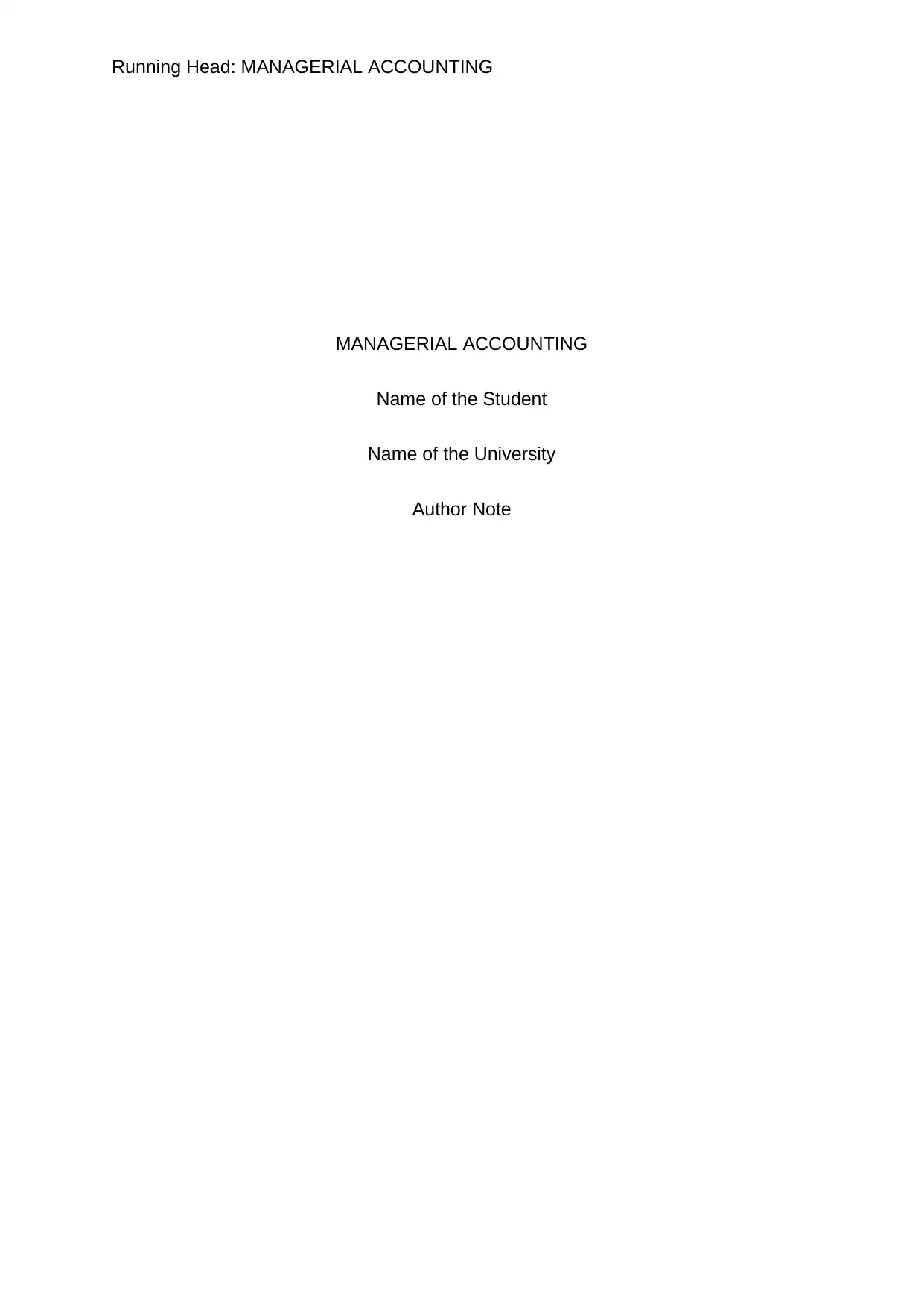
Running Head: MANAGERIAL ACCOUNTING
MANAGERIAL ACCOUNTING
Name of the Student
Name of the University
Author Note
MANAGERIAL ACCOUNTING
Name of the Student
Name of the University
Author Note
Paraphrase This Document
Need a fresh take? Get an instant paraphrase of this document with our AI Paraphraser
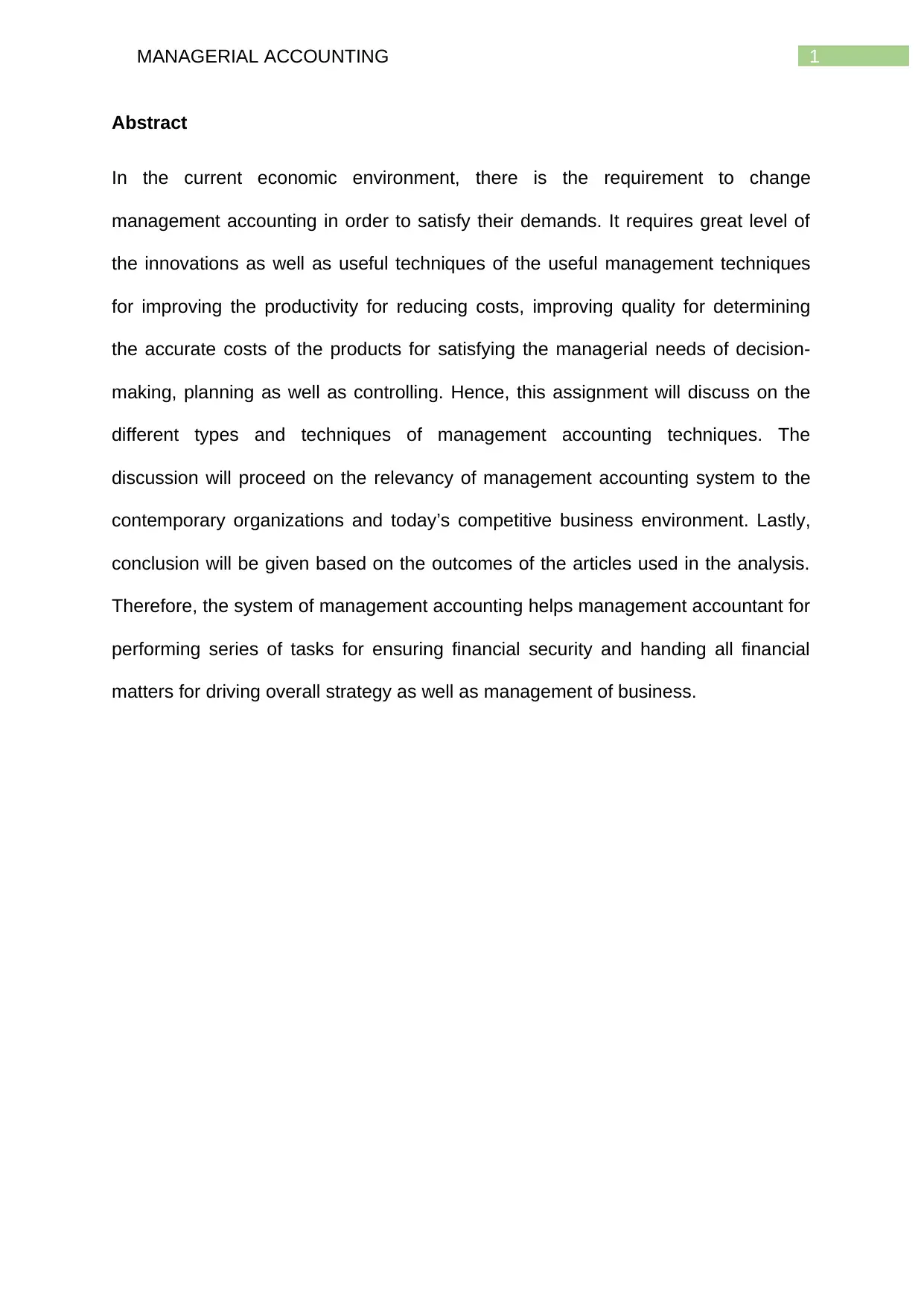
1MANAGERIAL ACCOUNTING
Abstract
In the current economic environment, there is the requirement to change
management accounting in order to satisfy their demands. It requires great level of
the innovations as well as useful techniques of the useful management techniques
for improving the productivity for reducing costs, improving quality for determining
the accurate costs of the products for satisfying the managerial needs of decision-
making, planning as well as controlling. Hence, this assignment will discuss on the
different types and techniques of management accounting techniques. The
discussion will proceed on the relevancy of management accounting system to the
contemporary organizations and today’s competitive business environment. Lastly,
conclusion will be given based on the outcomes of the articles used in the analysis.
Therefore, the system of management accounting helps management accountant for
performing series of tasks for ensuring financial security and handing all financial
matters for driving overall strategy as well as management of business.
Abstract
In the current economic environment, there is the requirement to change
management accounting in order to satisfy their demands. It requires great level of
the innovations as well as useful techniques of the useful management techniques
for improving the productivity for reducing costs, improving quality for determining
the accurate costs of the products for satisfying the managerial needs of decision-
making, planning as well as controlling. Hence, this assignment will discuss on the
different types and techniques of management accounting techniques. The
discussion will proceed on the relevancy of management accounting system to the
contemporary organizations and today’s competitive business environment. Lastly,
conclusion will be given based on the outcomes of the articles used in the analysis.
Therefore, the system of management accounting helps management accountant for
performing series of tasks for ensuring financial security and handing all financial
matters for driving overall strategy as well as management of business.
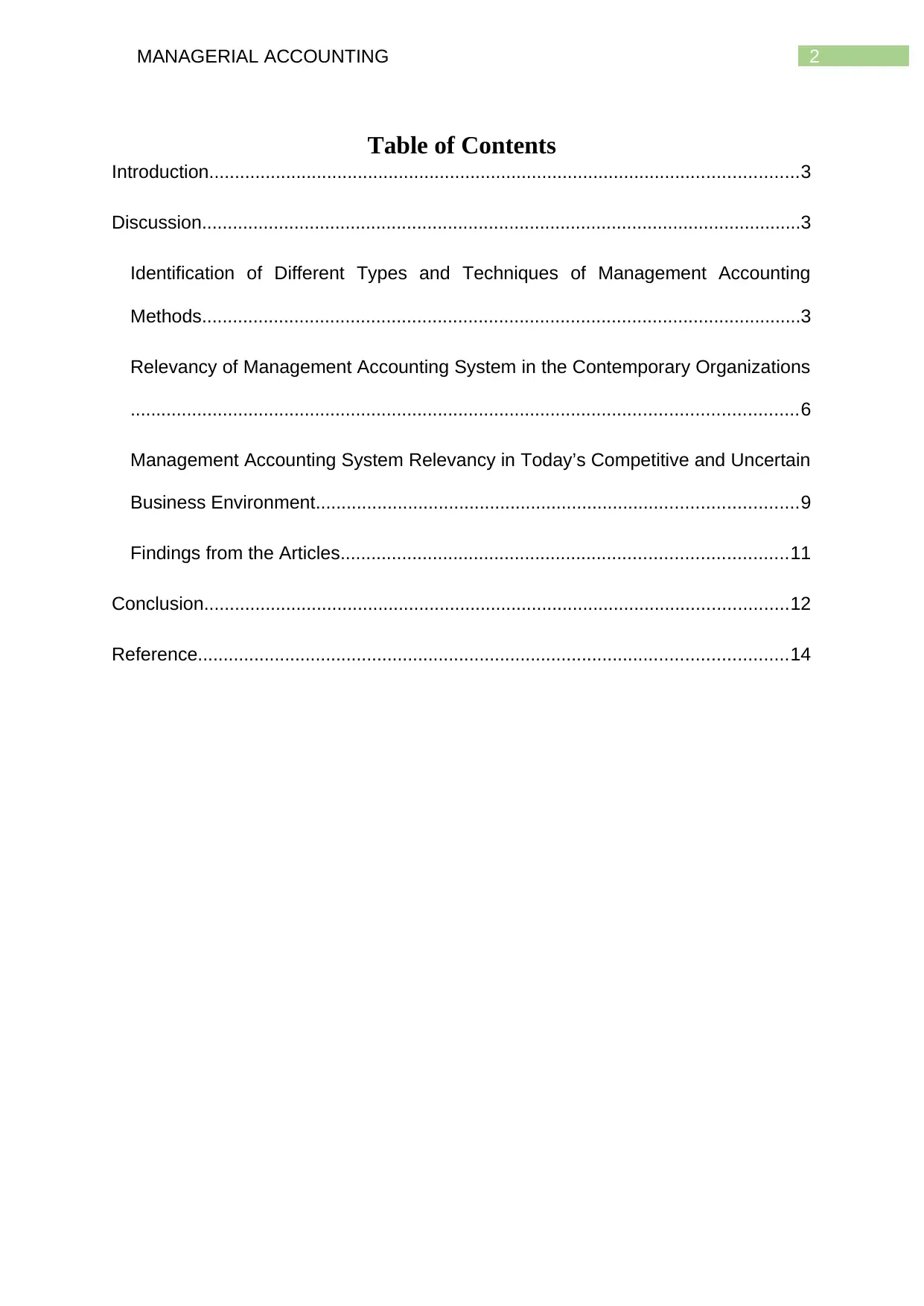
2MANAGERIAL ACCOUNTING
Table of Contents
Introduction...................................................................................................................3
Discussion.....................................................................................................................3
Identification of Different Types and Techniques of Management Accounting
Methods.....................................................................................................................3
Relevancy of Management Accounting System in the Contemporary Organizations
..................................................................................................................................6
Management Accounting System Relevancy in Today’s Competitive and Uncertain
Business Environment..............................................................................................9
Findings from the Articles.......................................................................................11
Conclusion..................................................................................................................12
Reference...................................................................................................................14
Table of Contents
Introduction...................................................................................................................3
Discussion.....................................................................................................................3
Identification of Different Types and Techniques of Management Accounting
Methods.....................................................................................................................3
Relevancy of Management Accounting System in the Contemporary Organizations
..................................................................................................................................6
Management Accounting System Relevancy in Today’s Competitive and Uncertain
Business Environment..............................................................................................9
Findings from the Articles.......................................................................................11
Conclusion..................................................................................................................12
Reference...................................................................................................................14
⊘ This is a preview!⊘
Do you want full access?
Subscribe today to unlock all pages.

Trusted by 1+ million students worldwide
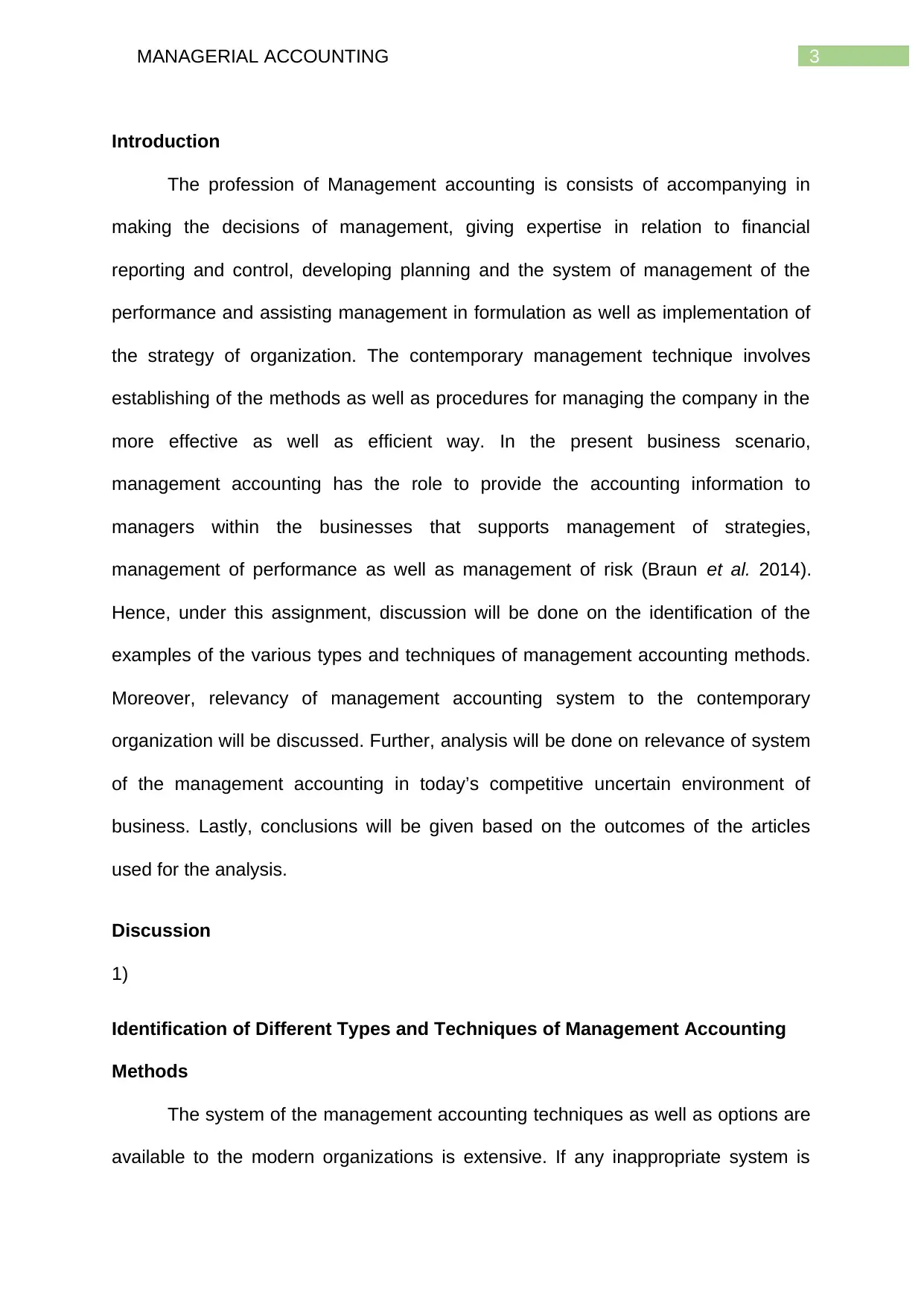
3MANAGERIAL ACCOUNTING
Introduction
The profession of Management accounting is consists of accompanying in
making the decisions of management, giving expertise in relation to financial
reporting and control, developing planning and the system of management of the
performance and assisting management in formulation as well as implementation of
the strategy of organization. The contemporary management technique involves
establishing of the methods as well as procedures for managing the company in the
more effective as well as efficient way. In the present business scenario,
management accounting has the role to provide the accounting information to
managers within the businesses that supports management of strategies,
management of performance as well as management of risk (Braun et al. 2014).
Hence, under this assignment, discussion will be done on the identification of the
examples of the various types and techniques of management accounting methods.
Moreover, relevancy of management accounting system to the contemporary
organization will be discussed. Further, analysis will be done on relevance of system
of the management accounting in today’s competitive uncertain environment of
business. Lastly, conclusions will be given based on the outcomes of the articles
used for the analysis.
Discussion
1)
Identification of Different Types and Techniques of Management Accounting
Methods
The system of the management accounting techniques as well as options are
available to the modern organizations is extensive. If any inappropriate system is
Introduction
The profession of Management accounting is consists of accompanying in
making the decisions of management, giving expertise in relation to financial
reporting and control, developing planning and the system of management of the
performance and assisting management in formulation as well as implementation of
the strategy of organization. The contemporary management technique involves
establishing of the methods as well as procedures for managing the company in the
more effective as well as efficient way. In the present business scenario,
management accounting has the role to provide the accounting information to
managers within the businesses that supports management of strategies,
management of performance as well as management of risk (Braun et al. 2014).
Hence, under this assignment, discussion will be done on the identification of the
examples of the various types and techniques of management accounting methods.
Moreover, relevancy of management accounting system to the contemporary
organization will be discussed. Further, analysis will be done on relevance of system
of the management accounting in today’s competitive uncertain environment of
business. Lastly, conclusions will be given based on the outcomes of the articles
used for the analysis.
Discussion
1)
Identification of Different Types and Techniques of Management Accounting
Methods
The system of the management accounting techniques as well as options are
available to the modern organizations is extensive. If any inappropriate system is
Paraphrase This Document
Need a fresh take? Get an instant paraphrase of this document with our AI Paraphraser
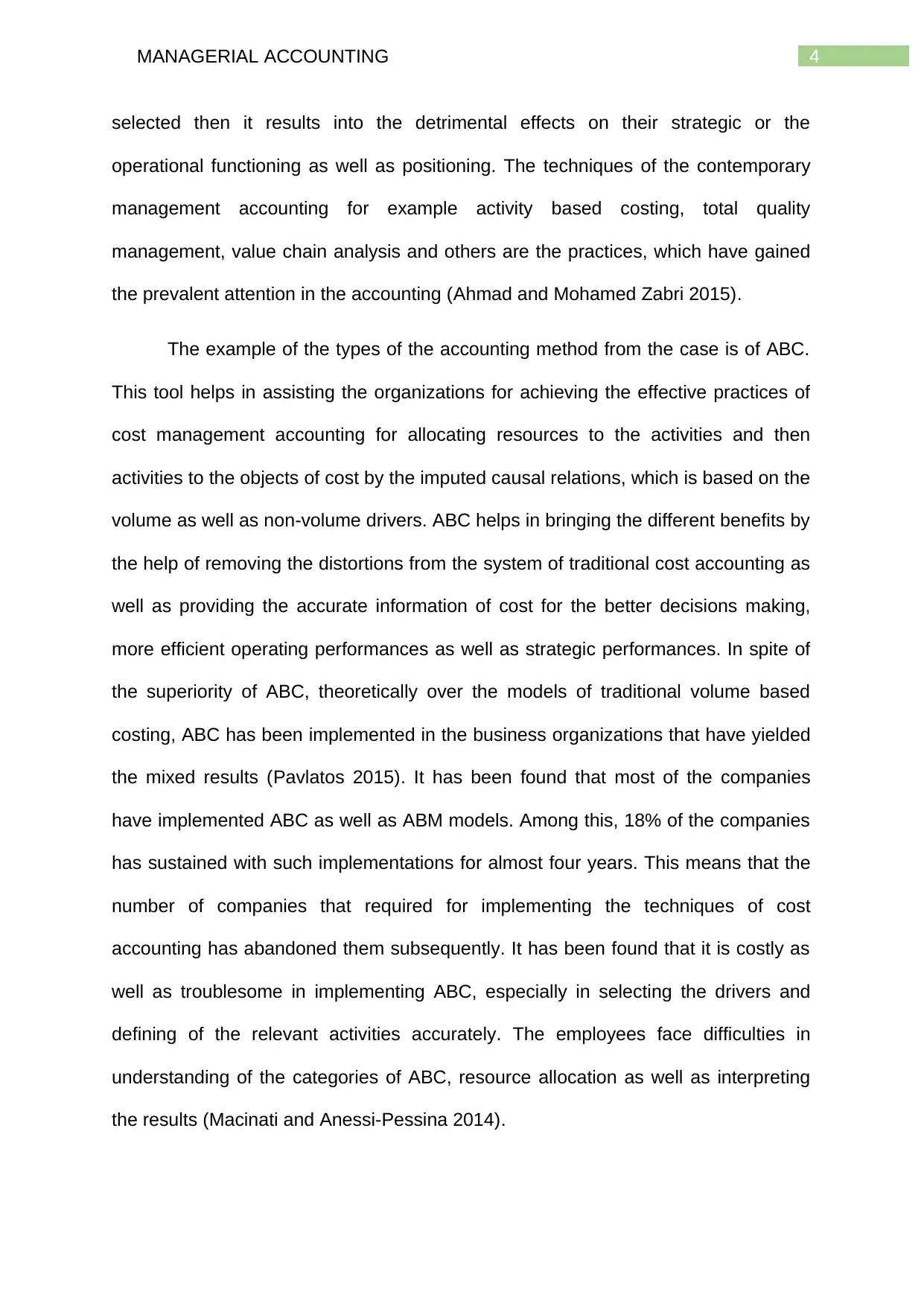
4MANAGERIAL ACCOUNTING
selected then it results into the detrimental effects on their strategic or the
operational functioning as well as positioning. The techniques of the contemporary
management accounting for example activity based costing, total quality
management, value chain analysis and others are the practices, which have gained
the prevalent attention in the accounting (Ahmad and Mohamed Zabri 2015).
The example of the types of the accounting method from the case is of ABC.
This tool helps in assisting the organizations for achieving the effective practices of
cost management accounting for allocating resources to the activities and then
activities to the objects of cost by the imputed causal relations, which is based on the
volume as well as non-volume drivers. ABC helps in bringing the different benefits by
the help of removing the distortions from the system of traditional cost accounting as
well as providing the accurate information of cost for the better decisions making,
more efficient operating performances as well as strategic performances. In spite of
the superiority of ABC, theoretically over the models of traditional volume based
costing, ABC has been implemented in the business organizations that have yielded
the mixed results (Pavlatos 2015). It has been found that most of the companies
have implemented ABC as well as ABM models. Among this, 18% of the companies
has sustained with such implementations for almost four years. This means that the
number of companies that required for implementing the techniques of cost
accounting has abandoned them subsequently. It has been found that it is costly as
well as troublesome in implementing ABC, especially in selecting the drivers and
defining of the relevant activities accurately. The employees face difficulties in
understanding of the categories of ABC, resource allocation as well as interpreting
the results (Macinati and Anessi-Pessina 2014).
selected then it results into the detrimental effects on their strategic or the
operational functioning as well as positioning. The techniques of the contemporary
management accounting for example activity based costing, total quality
management, value chain analysis and others are the practices, which have gained
the prevalent attention in the accounting (Ahmad and Mohamed Zabri 2015).
The example of the types of the accounting method from the case is of ABC.
This tool helps in assisting the organizations for achieving the effective practices of
cost management accounting for allocating resources to the activities and then
activities to the objects of cost by the imputed causal relations, which is based on the
volume as well as non-volume drivers. ABC helps in bringing the different benefits by
the help of removing the distortions from the system of traditional cost accounting as
well as providing the accurate information of cost for the better decisions making,
more efficient operating performances as well as strategic performances. In spite of
the superiority of ABC, theoretically over the models of traditional volume based
costing, ABC has been implemented in the business organizations that have yielded
the mixed results (Pavlatos 2015). It has been found that most of the companies
have implemented ABC as well as ABM models. Among this, 18% of the companies
has sustained with such implementations for almost four years. This means that the
number of companies that required for implementing the techniques of cost
accounting has abandoned them subsequently. It has been found that it is costly as
well as troublesome in implementing ABC, especially in selecting the drivers and
defining of the relevant activities accurately. The employees face difficulties in
understanding of the categories of ABC, resource allocation as well as interpreting
the results (Macinati and Anessi-Pessina 2014).
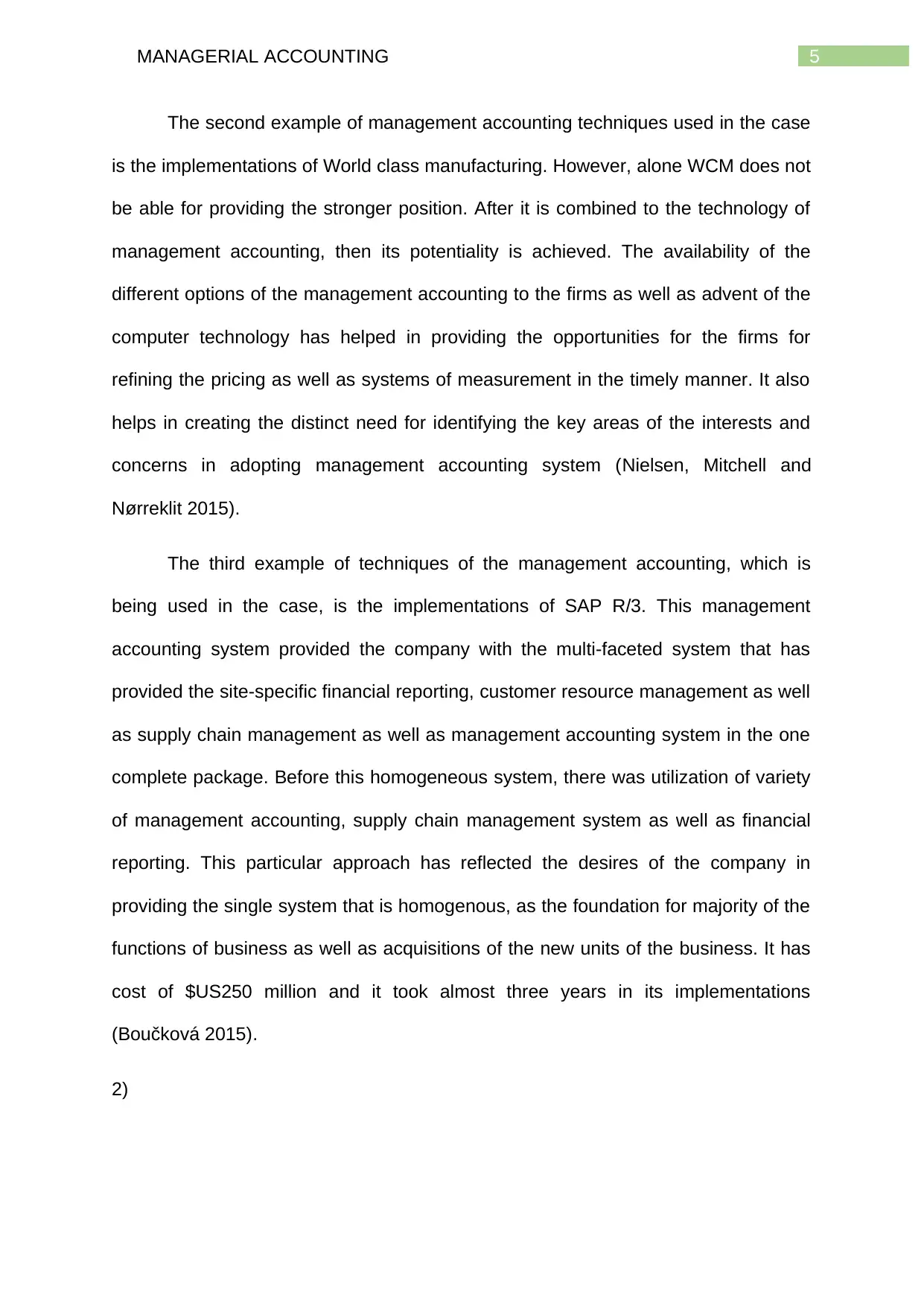
5MANAGERIAL ACCOUNTING
The second example of management accounting techniques used in the case
is the implementations of World class manufacturing. However, alone WCM does not
be able for providing the stronger position. After it is combined to the technology of
management accounting, then its potentiality is achieved. The availability of the
different options of the management accounting to the firms as well as advent of the
computer technology has helped in providing the opportunities for the firms for
refining the pricing as well as systems of measurement in the timely manner. It also
helps in creating the distinct need for identifying the key areas of the interests and
concerns in adopting management accounting system (Nielsen, Mitchell and
Nørreklit 2015).
The third example of techniques of the management accounting, which is
being used in the case, is the implementations of SAP R/3. This management
accounting system provided the company with the multi-faceted system that has
provided the site-specific financial reporting, customer resource management as well
as supply chain management as well as management accounting system in the one
complete package. Before this homogeneous system, there was utilization of variety
of management accounting, supply chain management system as well as financial
reporting. This particular approach has reflected the desires of the company in
providing the single system that is homogenous, as the foundation for majority of the
functions of business as well as acquisitions of the new units of the business. It has
cost of $US250 million and it took almost three years in its implementations
(Boučková 2015).
2)
The second example of management accounting techniques used in the case
is the implementations of World class manufacturing. However, alone WCM does not
be able for providing the stronger position. After it is combined to the technology of
management accounting, then its potentiality is achieved. The availability of the
different options of the management accounting to the firms as well as advent of the
computer technology has helped in providing the opportunities for the firms for
refining the pricing as well as systems of measurement in the timely manner. It also
helps in creating the distinct need for identifying the key areas of the interests and
concerns in adopting management accounting system (Nielsen, Mitchell and
Nørreklit 2015).
The third example of techniques of the management accounting, which is
being used in the case, is the implementations of SAP R/3. This management
accounting system provided the company with the multi-faceted system that has
provided the site-specific financial reporting, customer resource management as well
as supply chain management as well as management accounting system in the one
complete package. Before this homogeneous system, there was utilization of variety
of management accounting, supply chain management system as well as financial
reporting. This particular approach has reflected the desires of the company in
providing the single system that is homogenous, as the foundation for majority of the
functions of business as well as acquisitions of the new units of the business. It has
cost of $US250 million and it took almost three years in its implementations
(Boučková 2015).
2)
⊘ This is a preview!⊘
Do you want full access?
Subscribe today to unlock all pages.

Trusted by 1+ million students worldwide
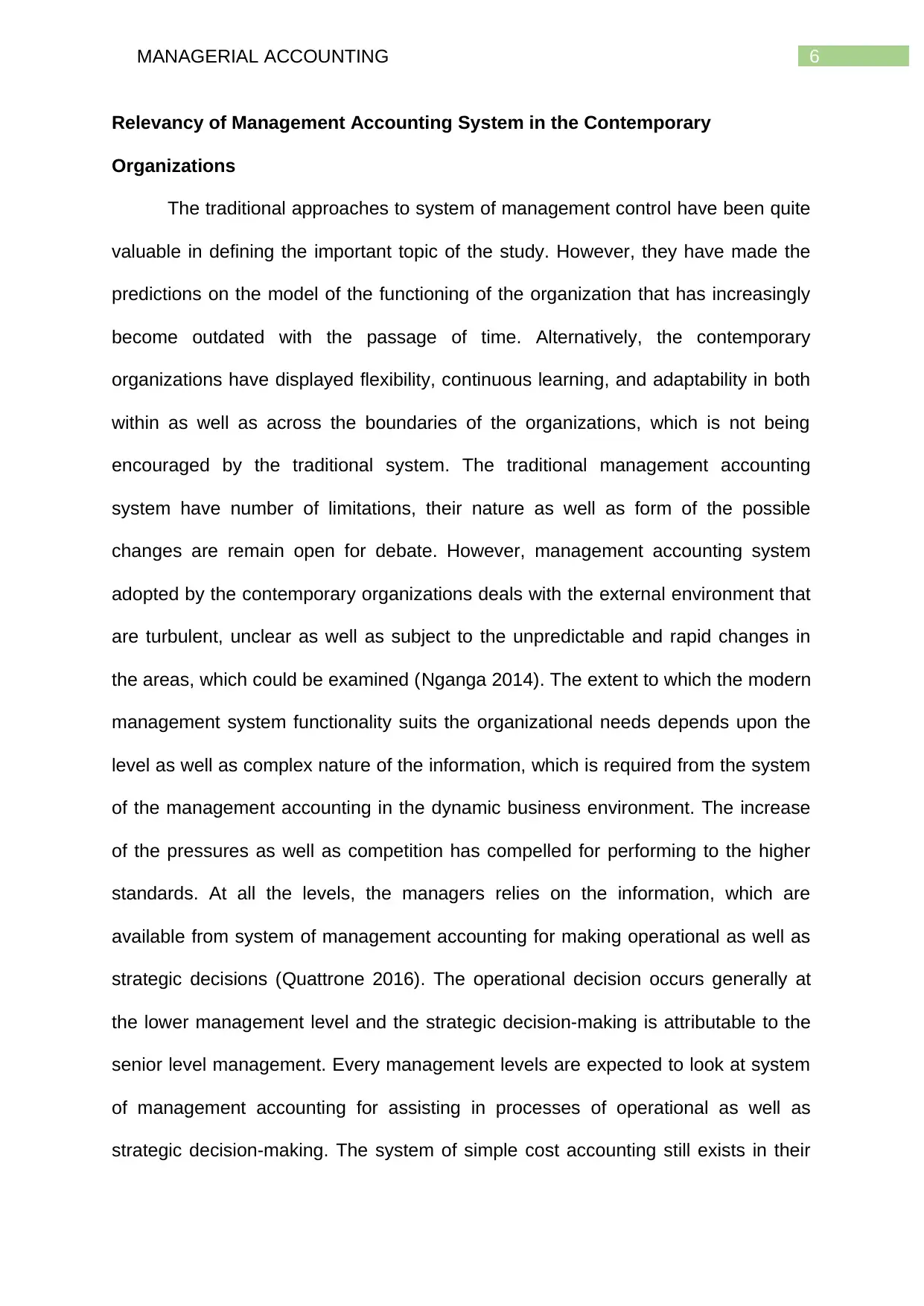
6MANAGERIAL ACCOUNTING
Relevancy of Management Accounting System in the Contemporary
Organizations
The traditional approaches to system of management control have been quite
valuable in defining the important topic of the study. However, they have made the
predictions on the model of the functioning of the organization that has increasingly
become outdated with the passage of time. Alternatively, the contemporary
organizations have displayed flexibility, continuous learning, and adaptability in both
within as well as across the boundaries of the organizations, which is not being
encouraged by the traditional system. The traditional management accounting
system have number of limitations, their nature as well as form of the possible
changes are remain open for debate. However, management accounting system
adopted by the contemporary organizations deals with the external environment that
are turbulent, unclear as well as subject to the unpredictable and rapid changes in
the areas, which could be examined (Nganga 2014). The extent to which the modern
management system functionality suits the organizational needs depends upon the
level as well as complex nature of the information, which is required from the system
of the management accounting in the dynamic business environment. The increase
of the pressures as well as competition has compelled for performing to the higher
standards. At all the levels, the managers relies on the information, which are
available from system of management accounting for making operational as well as
strategic decisions (Quattrone 2016). The operational decision occurs generally at
the lower management level and the strategic decision-making is attributable to the
senior level management. Every management levels are expected to look at system
of management accounting for assisting in processes of operational as well as
strategic decision-making. The system of simple cost accounting still exists in their
Relevancy of Management Accounting System in the Contemporary
Organizations
The traditional approaches to system of management control have been quite
valuable in defining the important topic of the study. However, they have made the
predictions on the model of the functioning of the organization that has increasingly
become outdated with the passage of time. Alternatively, the contemporary
organizations have displayed flexibility, continuous learning, and adaptability in both
within as well as across the boundaries of the organizations, which is not being
encouraged by the traditional system. The traditional management accounting
system have number of limitations, their nature as well as form of the possible
changes are remain open for debate. However, management accounting system
adopted by the contemporary organizations deals with the external environment that
are turbulent, unclear as well as subject to the unpredictable and rapid changes in
the areas, which could be examined (Nganga 2014). The extent to which the modern
management system functionality suits the organizational needs depends upon the
level as well as complex nature of the information, which is required from the system
of the management accounting in the dynamic business environment. The increase
of the pressures as well as competition has compelled for performing to the higher
standards. At all the levels, the managers relies on the information, which are
available from system of management accounting for making operational as well as
strategic decisions (Quattrone 2016). The operational decision occurs generally at
the lower management level and the strategic decision-making is attributable to the
senior level management. Every management levels are expected to look at system
of management accounting for assisting in processes of operational as well as
strategic decision-making. The system of simple cost accounting still exists in their
Paraphrase This Document
Need a fresh take? Get an instant paraphrase of this document with our AI Paraphraser
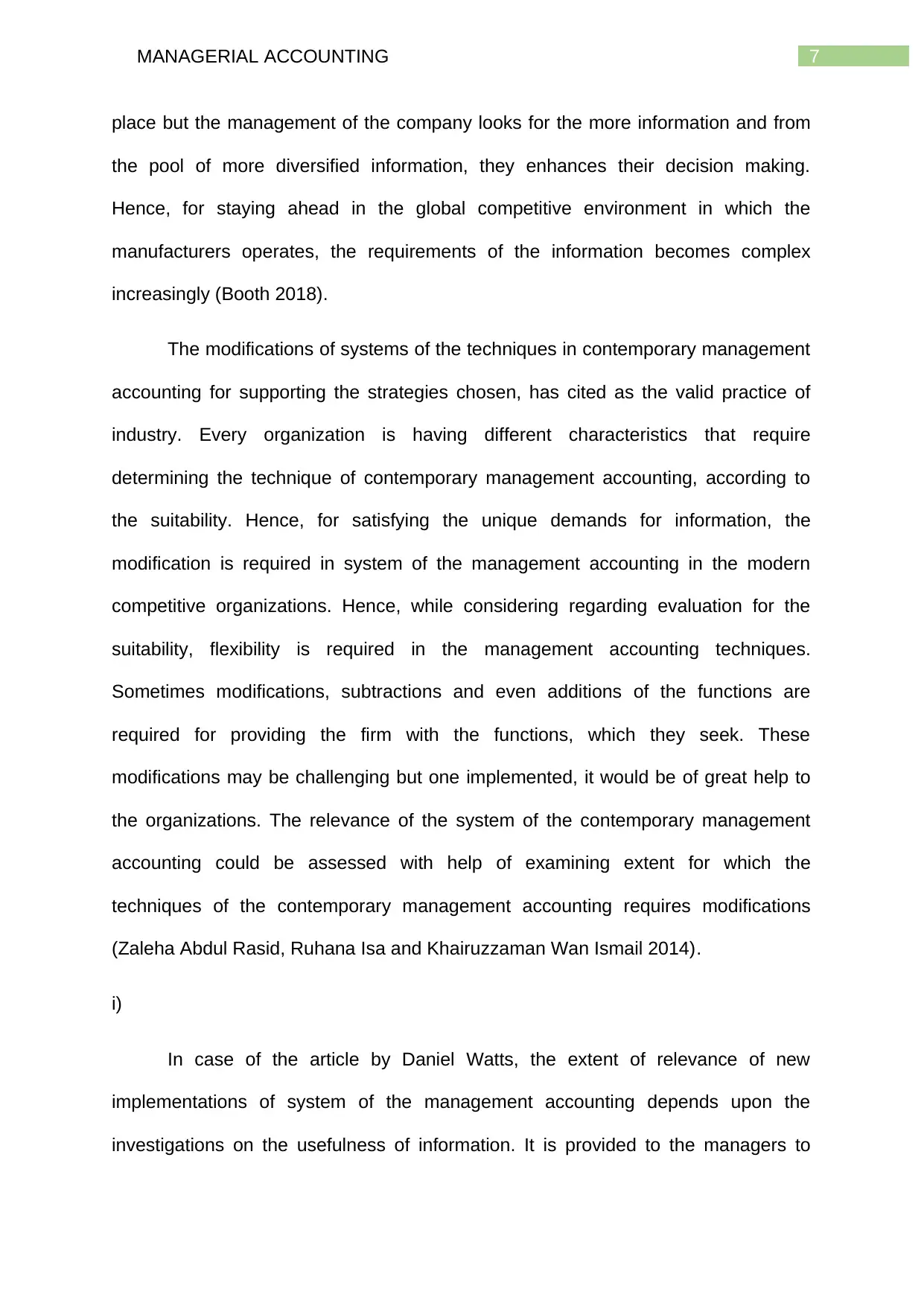
7MANAGERIAL ACCOUNTING
place but the management of the company looks for the more information and from
the pool of more diversified information, they enhances their decision making.
Hence, for staying ahead in the global competitive environment in which the
manufacturers operates, the requirements of the information becomes complex
increasingly (Booth 2018).
The modifications of systems of the techniques in contemporary management
accounting for supporting the strategies chosen, has cited as the valid practice of
industry. Every organization is having different characteristics that require
determining the technique of contemporary management accounting, according to
the suitability. Hence, for satisfying the unique demands for information, the
modification is required in system of the management accounting in the modern
competitive organizations. Hence, while considering regarding evaluation for the
suitability, flexibility is required in the management accounting techniques.
Sometimes modifications, subtractions and even additions of the functions are
required for providing the firm with the functions, which they seek. These
modifications may be challenging but one implemented, it would be of great help to
the organizations. The relevance of the system of the contemporary management
accounting could be assessed with help of examining extent for which the
techniques of the contemporary management accounting requires modifications
(Zaleha Abdul Rasid, Ruhana Isa and Khairuzzaman Wan Ismail 2014).
i)
In case of the article by Daniel Watts, the extent of relevance of new
implementations of system of the management accounting depends upon the
investigations on the usefulness of information. It is provided to the managers to
place but the management of the company looks for the more information and from
the pool of more diversified information, they enhances their decision making.
Hence, for staying ahead in the global competitive environment in which the
manufacturers operates, the requirements of the information becomes complex
increasingly (Booth 2018).
The modifications of systems of the techniques in contemporary management
accounting for supporting the strategies chosen, has cited as the valid practice of
industry. Every organization is having different characteristics that require
determining the technique of contemporary management accounting, according to
the suitability. Hence, for satisfying the unique demands for information, the
modification is required in system of the management accounting in the modern
competitive organizations. Hence, while considering regarding evaluation for the
suitability, flexibility is required in the management accounting techniques.
Sometimes modifications, subtractions and even additions of the functions are
required for providing the firm with the functions, which they seek. These
modifications may be challenging but one implemented, it would be of great help to
the organizations. The relevance of the system of the contemporary management
accounting could be assessed with help of examining extent for which the
techniques of the contemporary management accounting requires modifications
(Zaleha Abdul Rasid, Ruhana Isa and Khairuzzaman Wan Ismail 2014).
i)
In case of the article by Daniel Watts, the extent of relevance of new
implementations of system of the management accounting depends upon the
investigations on the usefulness of information. It is provided to the managers to
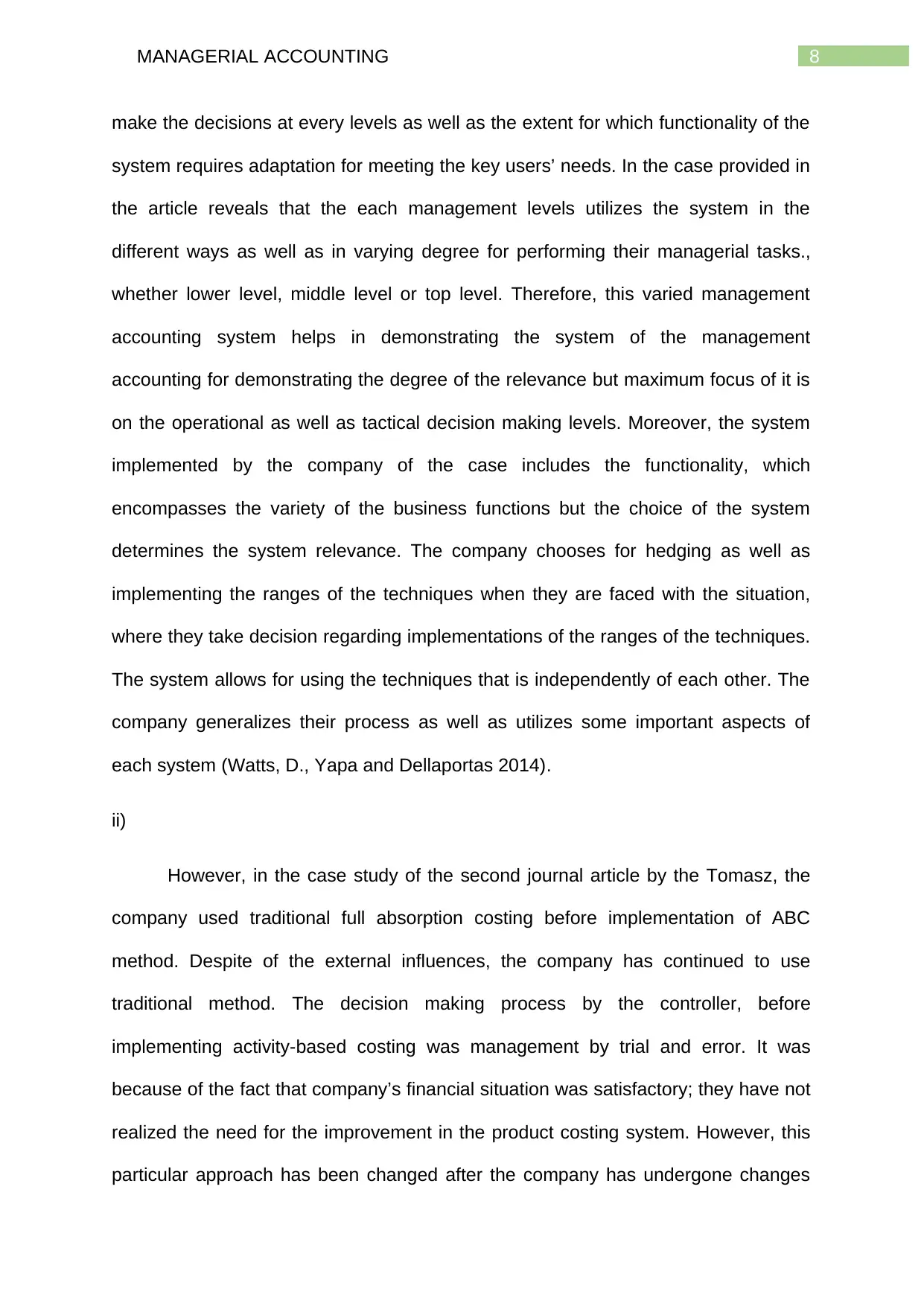
8MANAGERIAL ACCOUNTING
make the decisions at every levels as well as the extent for which functionality of the
system requires adaptation for meeting the key users’ needs. In the case provided in
the article reveals that the each management levels utilizes the system in the
different ways as well as in varying degree for performing their managerial tasks.,
whether lower level, middle level or top level. Therefore, this varied management
accounting system helps in demonstrating the system of the management
accounting for demonstrating the degree of the relevance but maximum focus of it is
on the operational as well as tactical decision making levels. Moreover, the system
implemented by the company of the case includes the functionality, which
encompasses the variety of the business functions but the choice of the system
determines the system relevance. The company chooses for hedging as well as
implementing the ranges of the techniques when they are faced with the situation,
where they take decision regarding implementations of the ranges of the techniques.
The system allows for using the techniques that is independently of each other. The
company generalizes their process as well as utilizes some important aspects of
each system (Watts, D., Yapa and Dellaportas 2014).
ii)
However, in the case study of the second journal article by the Tomasz, the
company used traditional full absorption costing before implementation of ABC
method. Despite of the external influences, the company has continued to use
traditional method. The decision making process by the controller, before
implementing activity-based costing was management by trial and error. It was
because of the fact that company’s financial situation was satisfactory; they have not
realized the need for the improvement in the product costing system. However, this
particular approach has been changed after the company has undergone changes
make the decisions at every levels as well as the extent for which functionality of the
system requires adaptation for meeting the key users’ needs. In the case provided in
the article reveals that the each management levels utilizes the system in the
different ways as well as in varying degree for performing their managerial tasks.,
whether lower level, middle level or top level. Therefore, this varied management
accounting system helps in demonstrating the system of the management
accounting for demonstrating the degree of the relevance but maximum focus of it is
on the operational as well as tactical decision making levels. Moreover, the system
implemented by the company of the case includes the functionality, which
encompasses the variety of the business functions but the choice of the system
determines the system relevance. The company chooses for hedging as well as
implementing the ranges of the techniques when they are faced with the situation,
where they take decision regarding implementations of the ranges of the techniques.
The system allows for using the techniques that is independently of each other. The
company generalizes their process as well as utilizes some important aspects of
each system (Watts, D., Yapa and Dellaportas 2014).
ii)
However, in the case study of the second journal article by the Tomasz, the
company used traditional full absorption costing before implementation of ABC
method. Despite of the external influences, the company has continued to use
traditional method. The decision making process by the controller, before
implementing activity-based costing was management by trial and error. It was
because of the fact that company’s financial situation was satisfactory; they have not
realized the need for the improvement in the product costing system. However, this
particular approach has been changed after the company has undergone changes
⊘ This is a preview!⊘
Do you want full access?
Subscribe today to unlock all pages.

Trusted by 1+ million students worldwide
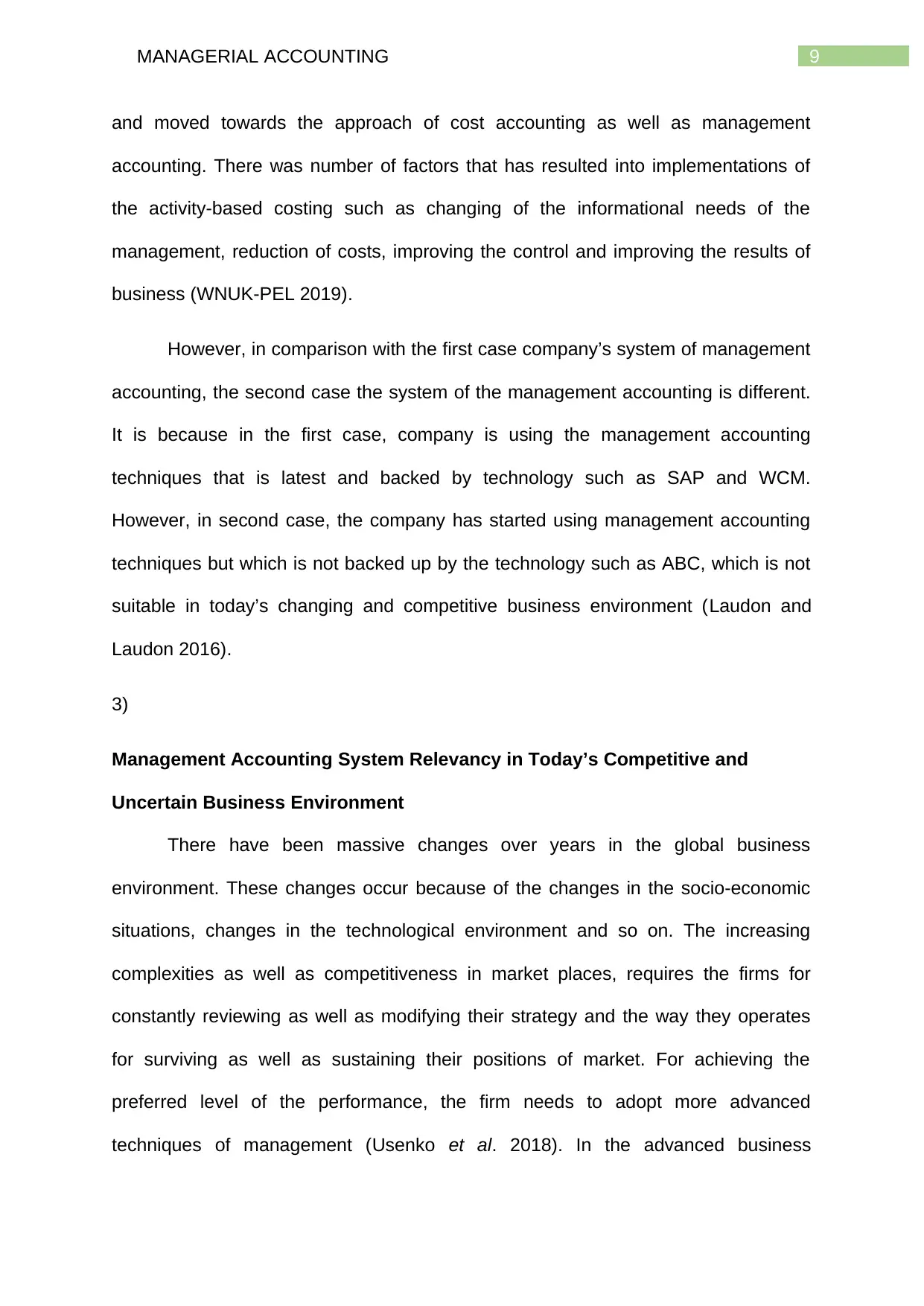
9MANAGERIAL ACCOUNTING
and moved towards the approach of cost accounting as well as management
accounting. There was number of factors that has resulted into implementations of
the activity-based costing such as changing of the informational needs of the
management, reduction of costs, improving the control and improving the results of
business (WNUK-PEL 2019).
However, in comparison with the first case company’s system of management
accounting, the second case the system of the management accounting is different.
It is because in the first case, company is using the management accounting
techniques that is latest and backed by technology such as SAP and WCM.
However, in second case, the company has started using management accounting
techniques but which is not backed up by the technology such as ABC, which is not
suitable in today’s changing and competitive business environment (Laudon and
Laudon 2016).
3)
Management Accounting System Relevancy in Today’s Competitive and
Uncertain Business Environment
There have been massive changes over years in the global business
environment. These changes occur because of the changes in the socio-economic
situations, changes in the technological environment and so on. The increasing
complexities as well as competitiveness in market places, requires the firms for
constantly reviewing as well as modifying their strategy and the way they operates
for surviving as well as sustaining their positions of market. For achieving the
preferred level of the performance, the firm needs to adopt more advanced
techniques of management (Usenko et al. 2018). In the advanced business
and moved towards the approach of cost accounting as well as management
accounting. There was number of factors that has resulted into implementations of
the activity-based costing such as changing of the informational needs of the
management, reduction of costs, improving the control and improving the results of
business (WNUK-PEL 2019).
However, in comparison with the first case company’s system of management
accounting, the second case the system of the management accounting is different.
It is because in the first case, company is using the management accounting
techniques that is latest and backed by technology such as SAP and WCM.
However, in second case, the company has started using management accounting
techniques but which is not backed up by the technology such as ABC, which is not
suitable in today’s changing and competitive business environment (Laudon and
Laudon 2016).
3)
Management Accounting System Relevancy in Today’s Competitive and
Uncertain Business Environment
There have been massive changes over years in the global business
environment. These changes occur because of the changes in the socio-economic
situations, changes in the technological environment and so on. The increasing
complexities as well as competitiveness in market places, requires the firms for
constantly reviewing as well as modifying their strategy and the way they operates
for surviving as well as sustaining their positions of market. For achieving the
preferred level of the performance, the firm needs to adopt more advanced
techniques of management (Usenko et al. 2018). In the advanced business
Paraphrase This Document
Need a fresh take? Get an instant paraphrase of this document with our AI Paraphraser
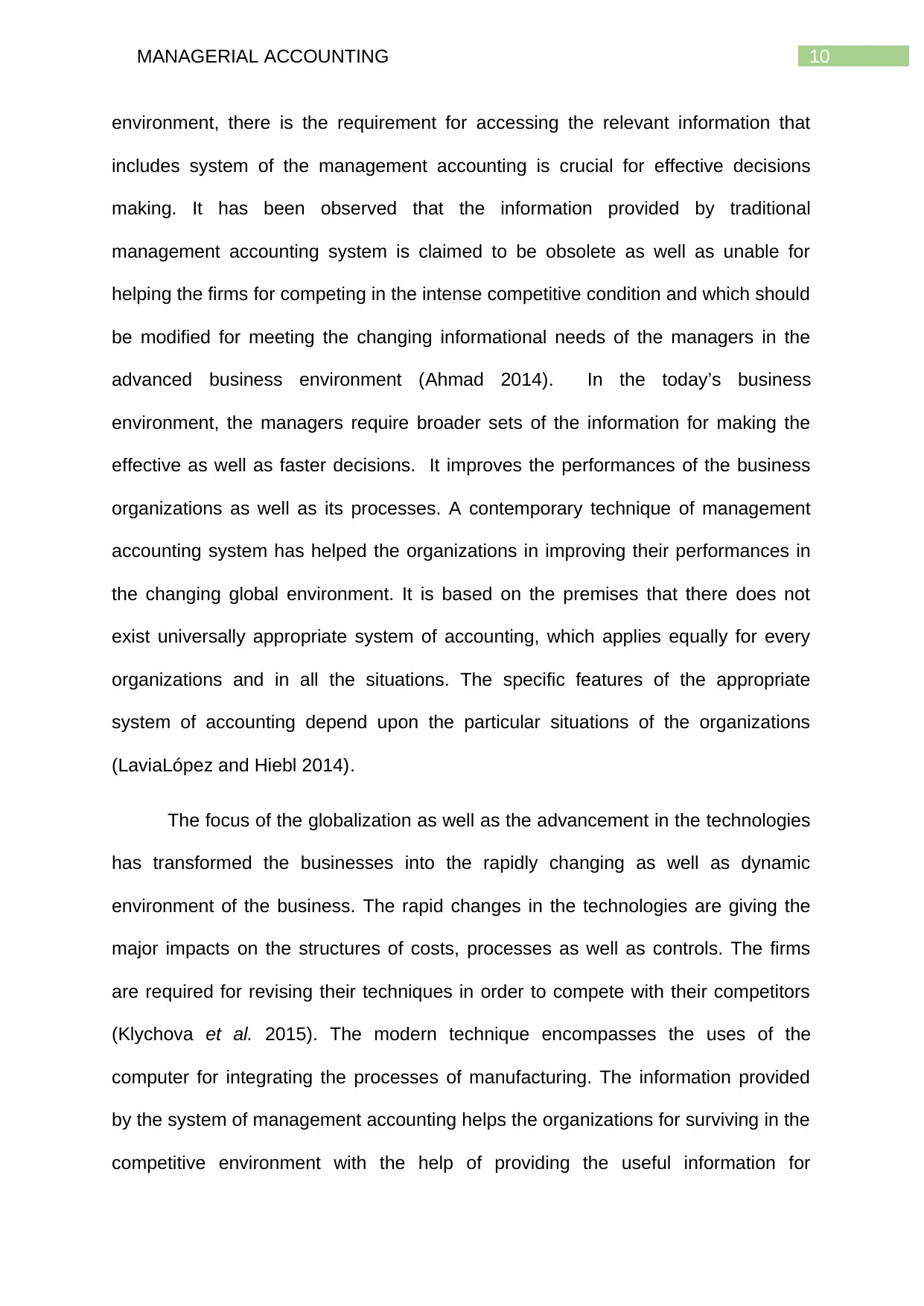
10MANAGERIAL ACCOUNTING
environment, there is the requirement for accessing the relevant information that
includes system of the management accounting is crucial for effective decisions
making. It has been observed that the information provided by traditional
management accounting system is claimed to be obsolete as well as unable for
helping the firms for competing in the intense competitive condition and which should
be modified for meeting the changing informational needs of the managers in the
advanced business environment (Ahmad 2014). In the today’s business
environment, the managers require broader sets of the information for making the
effective as well as faster decisions. It improves the performances of the business
organizations as well as its processes. A contemporary technique of management
accounting system has helped the organizations in improving their performances in
the changing global environment. It is based on the premises that there does not
exist universally appropriate system of accounting, which applies equally for every
organizations and in all the situations. The specific features of the appropriate
system of accounting depend upon the particular situations of the organizations
(LaviaLópez and Hiebl 2014).
The focus of the globalization as well as the advancement in the technologies
has transformed the businesses into the rapidly changing as well as dynamic
environment of the business. The rapid changes in the technologies are giving the
major impacts on the structures of costs, processes as well as controls. The firms
are required for revising their techniques in order to compete with their competitors
(Klychova et al. 2015). The modern technique encompasses the uses of the
computer for integrating the processes of manufacturing. The information provided
by the system of management accounting helps the organizations for surviving in the
competitive environment with the help of providing the useful information for
environment, there is the requirement for accessing the relevant information that
includes system of the management accounting is crucial for effective decisions
making. It has been observed that the information provided by traditional
management accounting system is claimed to be obsolete as well as unable for
helping the firms for competing in the intense competitive condition and which should
be modified for meeting the changing informational needs of the managers in the
advanced business environment (Ahmad 2014). In the today’s business
environment, the managers require broader sets of the information for making the
effective as well as faster decisions. It improves the performances of the business
organizations as well as its processes. A contemporary technique of management
accounting system has helped the organizations in improving their performances in
the changing global environment. It is based on the premises that there does not
exist universally appropriate system of accounting, which applies equally for every
organizations and in all the situations. The specific features of the appropriate
system of accounting depend upon the particular situations of the organizations
(LaviaLópez and Hiebl 2014).
The focus of the globalization as well as the advancement in the technologies
has transformed the businesses into the rapidly changing as well as dynamic
environment of the business. The rapid changes in the technologies are giving the
major impacts on the structures of costs, processes as well as controls. The firms
are required for revising their techniques in order to compete with their competitors
(Klychova et al. 2015). The modern technique encompasses the uses of the
computer for integrating the processes of manufacturing. The information provided
by the system of management accounting helps the organizations for surviving in the
competitive environment with the help of providing the useful information for
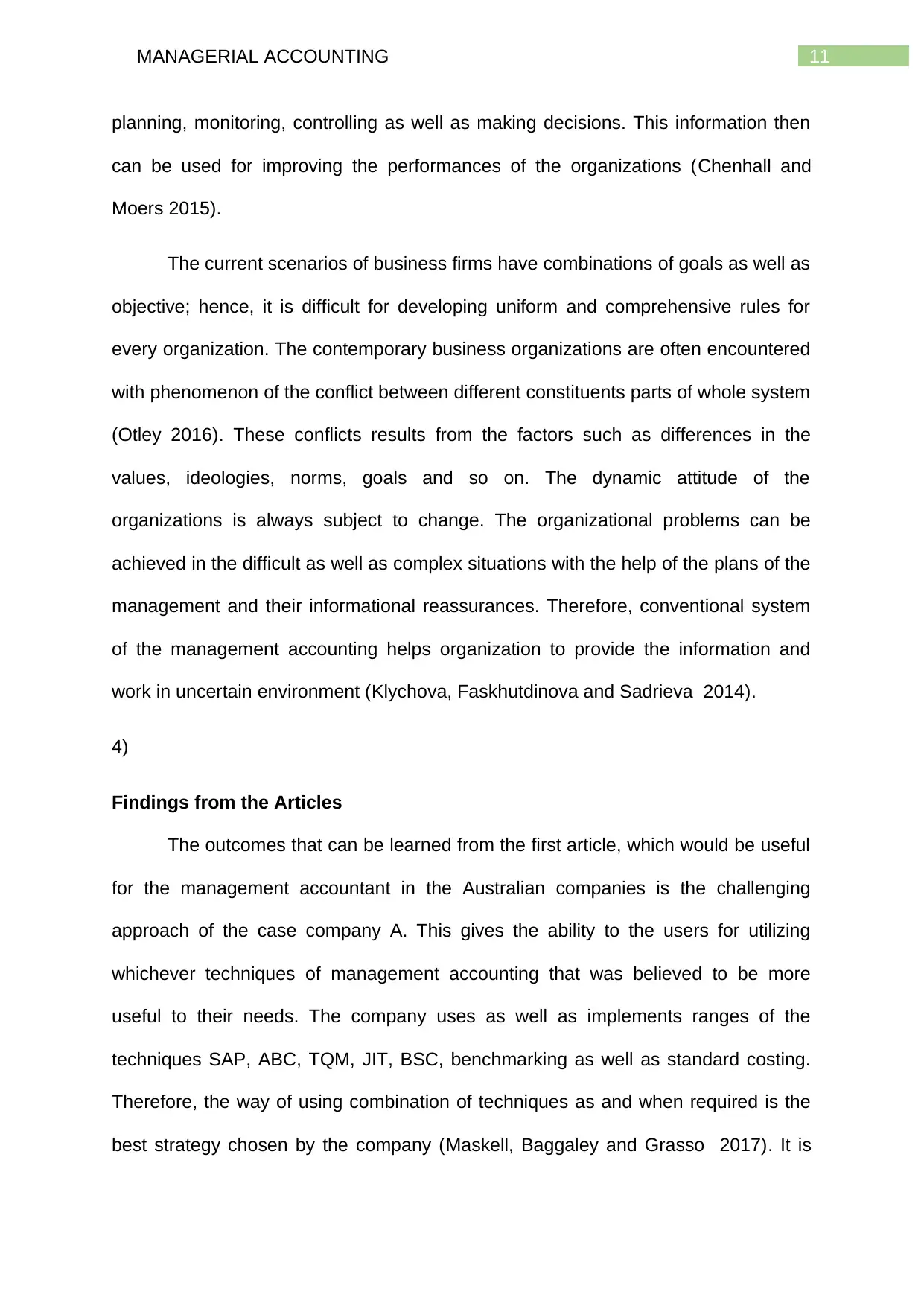
11MANAGERIAL ACCOUNTING
planning, monitoring, controlling as well as making decisions. This information then
can be used for improving the performances of the organizations (Chenhall and
Moers 2015).
The current scenarios of business firms have combinations of goals as well as
objective; hence, it is difficult for developing uniform and comprehensive rules for
every organization. The contemporary business organizations are often encountered
with phenomenon of the conflict between different constituents parts of whole system
(Otley 2016). These conflicts results from the factors such as differences in the
values, ideologies, norms, goals and so on. The dynamic attitude of the
organizations is always subject to change. The organizational problems can be
achieved in the difficult as well as complex situations with the help of the plans of the
management and their informational reassurances. Therefore, conventional system
of the management accounting helps organization to provide the information and
work in uncertain environment (Klychova, Faskhutdinova and Sadrieva 2014).
4)
Findings from the Articles
The outcomes that can be learned from the first article, which would be useful
for the management accountant in the Australian companies is the challenging
approach of the case company A. This gives the ability to the users for utilizing
whichever techniques of management accounting that was believed to be more
useful to their needs. The company uses as well as implements ranges of the
techniques SAP, ABC, TQM, JIT, BSC, benchmarking as well as standard costing.
Therefore, the way of using combination of techniques as and when required is the
best strategy chosen by the company (Maskell, Baggaley and Grasso 2017). It is
planning, monitoring, controlling as well as making decisions. This information then
can be used for improving the performances of the organizations (Chenhall and
Moers 2015).
The current scenarios of business firms have combinations of goals as well as
objective; hence, it is difficult for developing uniform and comprehensive rules for
every organization. The contemporary business organizations are often encountered
with phenomenon of the conflict between different constituents parts of whole system
(Otley 2016). These conflicts results from the factors such as differences in the
values, ideologies, norms, goals and so on. The dynamic attitude of the
organizations is always subject to change. The organizational problems can be
achieved in the difficult as well as complex situations with the help of the plans of the
management and their informational reassurances. Therefore, conventional system
of the management accounting helps organization to provide the information and
work in uncertain environment (Klychova, Faskhutdinova and Sadrieva 2014).
4)
Findings from the Articles
The outcomes that can be learned from the first article, which would be useful
for the management accountant in the Australian companies is the challenging
approach of the case company A. This gives the ability to the users for utilizing
whichever techniques of management accounting that was believed to be more
useful to their needs. The company uses as well as implements ranges of the
techniques SAP, ABC, TQM, JIT, BSC, benchmarking as well as standard costing.
Therefore, the way of using combination of techniques as and when required is the
best strategy chosen by the company (Maskell, Baggaley and Grasso 2017). It is
⊘ This is a preview!⊘
Do you want full access?
Subscribe today to unlock all pages.

Trusted by 1+ million students worldwide
1 out of 17
Related Documents
Your All-in-One AI-Powered Toolkit for Academic Success.
+13062052269
info@desklib.com
Available 24*7 on WhatsApp / Email
![[object Object]](/_next/static/media/star-bottom.7253800d.svg)
Unlock your academic potential
Copyright © 2020–2025 A2Z Services. All Rights Reserved. Developed and managed by ZUCOL.




